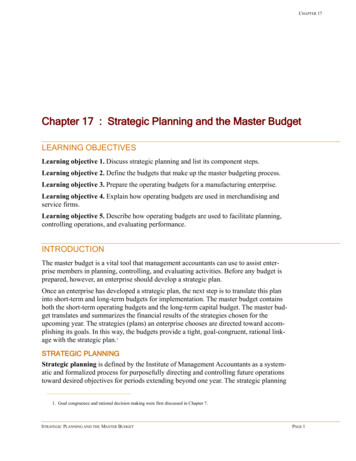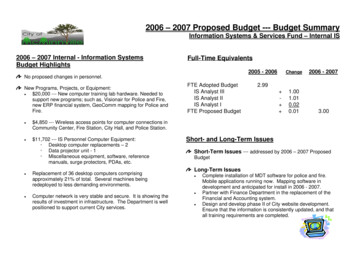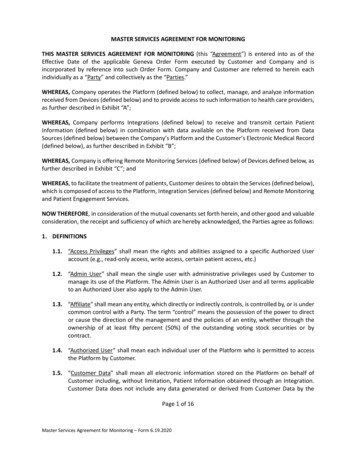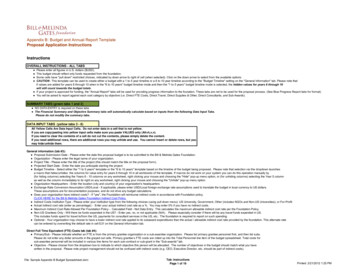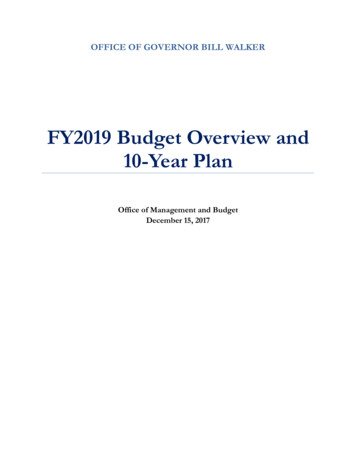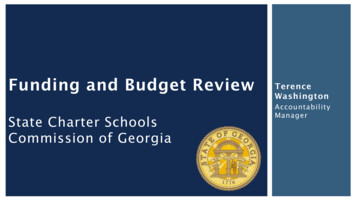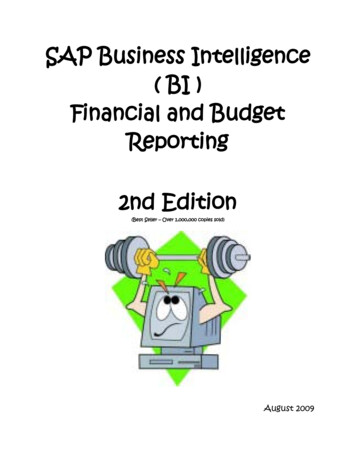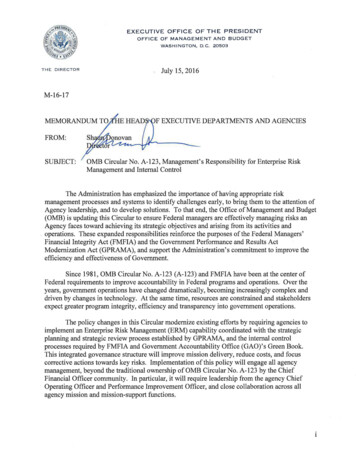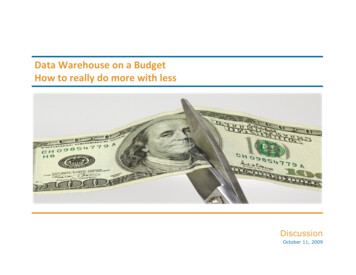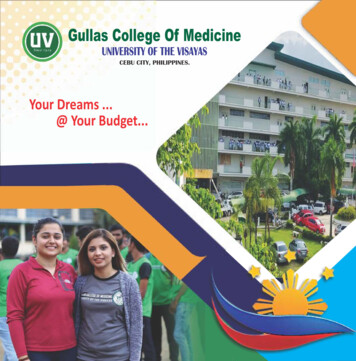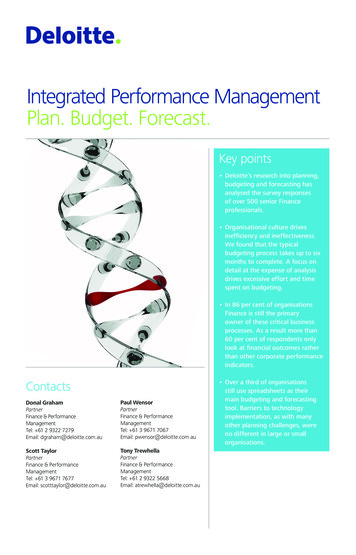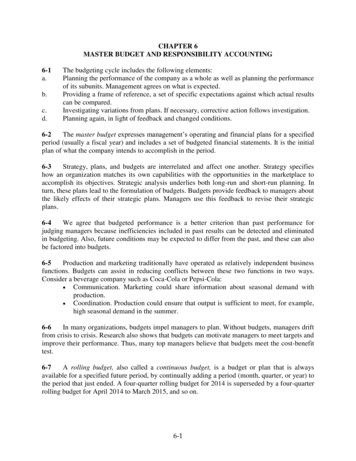
Transcription
CHAPTER 6MASTER BUDGET AND RESPONSIBILITY ACCOUNTING6-1a.b.c.d.The budgeting cycle includes the following elements:Planning the performance of the company as a whole as well as planning the performanceof its subunits. Management agrees on what is expected.Providing a frame of reference, a set of specific expectations against which actual resultscan be compared.Investigating variations from plans. If necessary, corrective action follows investigation.Planning again, in light of feedback and changed conditions.6-2The master budget expresses management’s operating and financial plans for a specifiedperiod (usually a fiscal year) and includes a set of budgeted financial statements. It is the initialplan of what the company intends to accomplish in the period.6-3Strategy, plans, and budgets are interrelated and affect one another. Strategy specifieshow an organization matches its own capabilities with the opportunities in the marketplace toaccomplish its objectives. Strategic analysis underlies both long-run and short-run planning. Inturn, these plans lead to the formulation of budgets. Budgets provide feedback to managers aboutthe likely effects of their strategic plans. Managers use this feedback to revise their strategicplans.6-4We agree that budgeted performance is a better criterion than past performance forjudging managers because inefficiencies included in past results can be detected and eliminatedin budgeting. Also, future conditions may be expected to differ from the past, and these can alsobe factored into budgets.6-5Production and marketing traditionally have operated as relatively independent businessfunctions. Budgets can assist in reducing conflicts between these two functions in two ways.Consider a beverage company such as Coca-Cola or Pepsi-Cola: Communication. Marketing could share information about seasonal demand withproduction. Coordination. Production could ensure that output is sufficient to meet, for example,high seasonal demand in the summer.6-6In many organizations, budgets impel managers to plan. Without budgets, managers driftfrom crisis to crisis. Research also shows that budgets can motivate managers to meet targets andimprove their performance. Thus, many top managers believe that budgets meet the cost-benefittest.6-7A rolling budget, also called a continuous budget, is a budget or plan that is alwaysavailable for a specified future period, by continually adding a period (month, quarter, or year) tothe period that just ended. A four-quarter rolling budget for 2014 is superseded by a four-quarterrolling budget for April 2014 to March 2015, and so on.6-1
6-8The steps in preparing an operating budget are as follows:1. Prepare the revenues budget.2. Prepare the production budget (in units).3. Prepare the direct material usage budget and direct material purchases budget.4. Prepare the direct manufacturing labor budget.5. Prepare the manufacturing overhead budget.6. Prepare the ending inventories budget.7. Prepare the cost of goods sold budget.8. Prepare the nonmanufacturing costs budget.9. Prepare the budgeted income statement.6-9The sales forecast is typically the cornerstone for budgeting because production (and,hence, costs) and inventory levels generally depend on the forecasted level of sales.6-10 Sensitivity analysis adds an extra dimension to budgeting. It enables managers toexamine how budgeted amounts change with a change in the underlying assumptions. Thisassists managers in monitoring those assumptions that are most critical to a company in attainingits budget and allows them to make timely adjustments to plans when appropriate.6-11 Kaizen budgeting explicitly incorporates continuous improvement anticipated during thebudget period into the budget numbers.6-12 Nonoutput-based cost drivers can be incorporated into budgeting by the use of activitybased budgeting (ABB). ABB focuses on the budgeted cost of activities necessary to produceand sell products and services. Nonoutput-based cost drivers, such as the number of parts,number of batches, and number of new products can be used with ABB.6-13 The choice of the type of responsibility center determines what the manager isaccountable for and thereby affects the manager’s behavior. For example, if a revenue center ischosen, the manager will focus on revenues, not on costs or investments. The choice of aresponsibility center type guides the variables to be included in the budgeting exercise.6-14 Budgeting in multinational companies may involve budgeting in several different foreigncurrencies. Further, management accountants must translate operating performance into a singlecurrency for reporting to shareholders by budgeting for exchange rates. Managers andaccountants must understand the factors that impact exchange rates and, where possible, planfinancial strategies to limit the downside of unexpected unfavorable moves in currencyvaluations. In developing budgets for operations in different countries, they must also have goodunderstanding of political, legal, and economic issues in those countries.6-15 No. Cash budgets and operating income budgets must be prepared simultaneously. Inpreparing their operating income budgets, companies want to avoid unnecessary idle cash andunexpected cash deficiencies. The cash budget, unlike the operating income budget, highlightsperiods of idle cash and periods of cash shortage, and it allows the accountant to plan costeffective ways of either using excess cash or raising cash from outside to achieve the company’soperating income goals.6-2
6-16(15 min.) Sales budget, service setting.1.2014Volume12,20016,400Rouse & SonsRadon TestsLead TestsAt 2014Selling Prices 290 240Expected 2015Change in Volume 6%–10%Expected 2015Volume12,93214,760Rouse & Sons Sales BudgetFor the Year Ended December 31, 2015Radon TestsLead TestsSellingPrice 290 240UnitsSold12,93214,760TotalRevenues 3,750,2803,542,400 7,292,6802.Rouse & SonsRadon TestsLead Tests2014Volume12,20016,400Planned 2015Selling Prices 290 230Expected 2015Change in Volume 6%–7%Expected2015 Volume12,93215,252Rouse & Sons Sales BudgetFor the Year Ended December 31, 2015Radon TestsLead TestsSellingPrice 290 230Units Sold12,93215,252TotalRevenues 3,750,2803,507,960 7,258,240Expected revenues at the new 2015 prices are 7,258,240, which is lower than the expected 2015revenues of 7,292,680 if the prices are unchanged. So, if the goal is to maximize sales revenueand if Jim Rouse’s forecasts are reliable, the company should not lower its price for a lead test in2015.6-3
6-17(5 min.)Sales and production budget.Budgeted sales in unitsAdd target ending finished goods inventoryTotal requirementsDeduct beginning finished goods inventoryUnits to be produced6-18(5 min.)208,00027,000235,00018,000217,000Direct materials purchases budget.Direct materials to be used in production (bottles)Add target ending direct materials inventory (bottles)Total requirements (bottles)Deduct beginning direct materials inventory (bottles)Direct materials to be purchased 19 (10 min.) Budgeting material purchases.Production Budget:Budgeted salesAdd target ending finished goods inventoryTotal requirementsDeduct beginning finished goods inventoryUnits to be producedFinished Goods(units)43,00019,00062,00011,00051,000Direct Materials Purchases Budget:Direct materials needed for production (51,000 4)Add target ending direct materials inventoryTotal requirementsDeduct beginning direct materials inventoryDirect materials to be purchased6-4Direct Materials(in gallons)204,00056,000260,00066,000194,000
6-20(15–20 min.) Revenues, production, and purchases budget.1.915,000 motorcycles 405,000 yen 370,575,000,000 yen2.Budgeted sales (motorcycles)Add target ending finished goods inventoryTotal requirementsDeduct beginning finished goods inventoryUnits to be produced3.Direct materials to be used in production,870,000 2 (wheels)Add target ending direct materials inventoryTotal requirementsDeduct beginning direct materials inventoryDirect materials to be purchased (wheels)Cost per wheel in yenDirect materials purchase cost in 001,812,00055,0001,757,000 18,000 31,626,000,0004. Note the relatively small inventory of wheels. In Japan, suppliers tend to be located veryclose to the major manufacturer. Inventories are controlled by just-in-time and similarsystems. Indeed, some direct materials inventories are almost nonexistent. Nevertheless,Yoshida’s managers would want to check why the target ending inventory of wheels (72,000)is greater than the beginning inventory of 55,000. Could the production process bestreamlined and made more efficient to reduce the need to hold more inventories?Furthermore, Yoshida could help improve quality, efficiency, and productivity of itswheels supplier to reduce the cost of manufacturing wheels and hence the price the suppliercharges Yoshida. Toyota routinely aids its suppliers in this way and also reduces coststhrough better coordination between suppliers and the company.6-5
6-21(30 min.) Revenues and production budget.1.12-ounce bottles1-gallon unitsab2.3.SellingPrice 0.201.50UnitsSold5,040,000a2,040,000bTotalRevenues 1,008,0003,060,000 4,068,000420,000 12 months 5,040,000170,000 12 months 2,040,000Budgeted unit sales (12-ounce bottles)Add target ending finished goods inventoryTotal requirementsDeduct beginning finished goods inventoryUnits to be eginning Budgeted Target Budgetedinventorysalesending inventory production 2,040,000 240,000 1,900,000 380,000 1-gallon units6-22 (30 min.) Budgeting: direct material usage, manufacturing cost, and gross margin.1.Direct Material Usage Budget in Quantity and DollarsMaterialWoolPhysical Units BudgetDirect materials required forBlue Rugs (200,000 rugs 36 skeins and 0.8 gal.)7,200,000 skeinsCost BudgetAvailable from beginning direct materials inventory:(a)Wool: 458,000 skeinsDye: 4,000 gallonsTo be purchased this period: (b)Wool: (7,200,000 – 458,000) skeins 2 per skeinDye: (160,000 – 4,000) gal. 6 per gal.Direct materials to be used this period: (a) (b)6-6 DyeTotal160,000 gal.961,800 23,68013,484,000 14,445,800936,000 959,680 15,405,480
2. 31, 620, 000Weaving budgeted 2.55 per DMLHoverhead rate12, 400, 000 DMLHDyeing budgeted 17, 280, 000 12 per MHoverhead rate1, 440, 000 MH3.Budgeted Unit Cost of Blue RugCost perUnit of Input 2613122.55WoolDyeDirect manufacturing laborDyeing overheadWeaving overheadTotal1Input perUnit ofOutput36 skeins0.8 gal.62 hrs.7.21 mach-hrs.62 DMLHTotal 72.004.80806.0086.40158.10 1,127.300.2 machine hour per skein 36 skeins per rug 7.2 machine-hrs. per rug.4.Revenue BudgetBlue RugsBlue RugsSellingUnits Price Total Revenues200,000 2,000 400,000,000185,000 2,000 370,000,0005a.Sales 200,000 rugsCost of Goods Sold BudgetFrom ScheduleBeginning finished goods inventoryDirect materials usedDirect manufacturing labor ( 806 200,000)Dyeing overhead ( 86.40 200,000)Weaving overhead ( 158.10 200,000)Cost of goods available for saleDeduct ending finished goods inventoryCost of goods sold6-7Total 480225,505,4800 225,505,480
5b.Sales 185,000 rugsCost of Goods Sold BudgetFrom ScheduleBeginning finished goods inventoryDirect materials usedDirect manufacturing labor ( 806 200,000)Dyeing overhead ( 86.40 200,000)Weaving overhead ( 158.10 200,000)Cost of goods available for saleDeduct ending finished goods inventory( 1,127.30 15,000)Cost of goods soldTotal 480225,505,48016,909,500 208,595,9806.RevenueLess: Cost of goods soldGross margin200,000 rugs sold 400,000,000225,505,480 174,494,520185,000 rugs sold 370,000,000208,595,980 161,404,0207.If sales drop to 185,000 blue rugs, Xander should look to reduce fixed costs and produceless to reduce variable costs and inventory costs.8.Top management can look for ways to increase (stretch) sales and improve quality,efficiency, and input prices to reduce costs in each cost category such as direct materials, directmanufacturing labor, and overhead costs. Top management can also use the budget to coordinateand communicate across different parts of the organization, create a framework for judgingperformance and facilitating learning, and motivate managers and employees to achieve ―stretch‖targets of higher revenues and lower costs.6-8
6-23 (45 min.) Budgeting: service company.1.Direct Labor Budget in Hours and DollarsTotalHours BudgetDirect labor hours required(2,000 jobs 5 hours per job)10,000 hoursCost BudgetWages (10,000 hours 12/hr.)Taxes and benefits (10,000 hours 12/hr. 20%) 120,00024,000 144,000 14.40/DLHCost per direct-labor hour ( 144,000/10,000 DLH)2.Travel budgeted overhead rate 60, 000 2.40 per mile25, 000 milesWindow washing budgeted overhead rate 122, 000 12.20 per DLH10, 000 DLH3.Budgeted Cost of Average 2,000 Square-Foot Window Washing JobDirect labor 144,000Travel overhead60,000Window washing overhead122,000Total Cost per Job 326,000Total Cost of 2,000 jobs 326,000Budgeted cost of average 2,000 square foot window washing job 326,000 2,000 163 perjob.4.Revenue BudgetPrice perSquare Foot Total Revenues2,000 jobs 2,000 sq. ft./job 4,000,000 sq. ft. 0.10 400,000Square Feet5.2,000 jobs 400,000326,000 74,000RevenueExpensesOperating Income6-9
6.Revenue BudgetPrice perSquare Foot Total RevenuesSquare Feet2,400 jobs 2,000 sq. ft./job 4,800,000 sq. ft. 0.10 480,0002,400 jobsRevenue 480,000Expenses ( 163 2,400 jobs) 15,000406,200Operating Income 73,800Decrease in net operating income: 74,000 – 73,800 200. According to this analysis, theincrease in revenue would not warrant the 15,000 of additional advertising cost. Therefore, theinvestment should not be made.7. Using the budgeted cost per job of 163 ig
6-1 CHAPTER 6 MASTER BUDGET AND RESPONSIBILITY ACCOUNTING 6-1 The budgeting cycle includes the following elements: a. Planning the performance of the company
